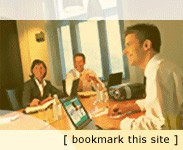 |

 |
| Advertisements |

|
|
 |
How to Design a Good Website
By TranslationDirectory.com,
www.TranslationDirectory.com
Become a member of TranslationDirectory.com at just
$12 per month (paid per year)
- Clearly define the purpose of building
your website. Ask yourself a question: “How will people
benefit from visiting my website?”
- Use an easy-to-remember domain name.
- Never make the home page with just one button: “Enter
the site” – you should never create an extra “click” level,
if that is not absolutely necessary.
- Use “expandable” design so that the site gets a nice look
on monitors with different resolutions.
- Use consistent color-structure and layout on all pages.
- Use a lot of white (background) space on the site.
- Use dark text on light background – otherwise it may be
painful for eyes to read the information.
- Do not use flash – or minimize its usage in your design.
- Do not create wide (tall) collages at the top – the top
of the site is most precious “real estate” of your site.
It should be used for the most important content of your
site (or for the most profitable advertising).
- Present information in short paragraphs.
- For each page: use unique concise (60-80 characters) but
meaningful title tag. The best title tag would be the one
that coincides with the search phrase you want searchers
to use in order to find your website – and that phrase must
exactly imply what your page is about.
- For each page use a unique description meta tag (160-180
characters).
- For each page: use about ten keyword phrases in the keyword
meta tag.
- Use descriptive, concise alt tags for your images. Don’t
stuff them with keywords!
- Make your TITLE and ALT tags descriptive, simple and keyword
rich. Avoid irrelevant and repeated keywords.
- Use a lot of photos and other graphical elements – people
enjoy reading books (magazines, newspapers) with pictures.
- Place a sign-up form at the top of your site – make it
easy for visitors to subscribe with you to receive news
and updates. Otherwise they may never come back.
- Use text links in the menu – it is easy to adjust the
text when needed in comparison with the graphical buttons.
If you still consider using graphic navigation, embed the
appropriate alt tags.
- Make it easy for visitors to get to any page from your
site to any other page – with as few clicks as possible.
You can realize that through a sitemap, through a comprehensive
menu placed at each page, through indication of the path
the visitors have taken from the main page to the current
page, by other means.
- Make it easy for visitors to contact you.
- Place the links to the most important pages at the top
of the menu.
- Place the most important pages into the root folder, less
important – into subfolders, the least important ones –
into subsubfolders.
- Guide visitors where you want them to go after they make
a certain action (after they read an article, submit a form
etc) by placing the relevant links after the article, form
etc. Tell your visitors exactly what you want them to do
at your web site. You may want them to order products, subscribe
to your ezine, etc.
- Keep online forms targeted and as short as possible.
- Place a “Recommend this page” link at the bottom of all
(major) pages of your web-site.
- Post polls related to the topic of your website.
- Make your site a useful profession resource in your field.
Stick with the main topic and publish relevant information.
- Don’t post anything that is useless for your visitors
(even if you believe it can help you with SEO etc). Make
your site for people, not for search engines.
- Place a search-bar at each page of your site – visitors
rarely have time to click through all the menu links and
would rather try to find directly what they need using search.
- Make sure your site works well in all major browsers.
- Add a “bookmark this page” link to all (major) pages.
- Smart categorization is of paramount importance when designing
your website. Think carefully how to split large chunks
of information so that they can have a unique category.
Make sure each category page has unique title, heading and
meta tags.
- You may also add a “make the starting page” script to
your site.
- If you wish to make the site even more “sticky” – add
a forum and/or a blog.
- If you are using paid advertising like AdWords, it can
be much more beneficial if the landing page directly invites
the visitor to register with your site or to sign up for
the newsletter. This way the price you are paying for the
click can become the price of the returning visitor. That
is very important as people rarely buy something immediately
after they click on an ad. And they rarely come back without
being reminded about your website.
- If you create a new page and want to have it spidered
quickly – place a link to it from your site’s main page
– at least temporarily.
- Make the links blue, or at least underlined.
- Avoid top navigation that has mouse-over drop downs. Not
SE friendly, users do not prefer them because the drop downs
often obstruct page content.
- Position Add to Cart button close to the price. Make the
“add to cart” button stand out in color and appearance.
- Position Checkout button LAST - easy to find.
- Position Continue Shopping button next to Checkout button.
- Offer multiple ways of payment.
- Avoid requiring registration before checkout – some people
hate registering in order to pay you for something.
- Proofread all the text - don't allow careless errors as
they can make your site look unprofessional.
- Create a “legal disclaimer”, and/or “privacy policy” and/or
“terms and conditions” pages.
- Validate your CSS and HTML. Check for errors and broken
links.
- Do not create multiple pages, sub-domains, domains with
the same content.
- Find a host that supports the If-Modified-Since HTTP header.
It tells search engines whether your content has changed
since your site was last crawled. It will save you bandwidth,
resources and avoid server overload.
- Fins a host that uses gzip compression.
- Do not use hidden text and links. Show the search engines
what you show to your visitors. Do not attempt to present
different content to search engines than what you show to
your site visitors.
- Don’t link to anti-Christian or unethical and illegal
sites.
Published - May 2009
Submit your article!
Read more articles - free!
Read sense of life articles!
E-mail
this article to your colleague!
Need
more translation jobs? Click here!
Translation
agencies are welcome to register here - Free!
Freelance
translators are welcome to register here - Free!
|
 |
 |
| Free
Newsletter |
 |
|
|
|
 |


